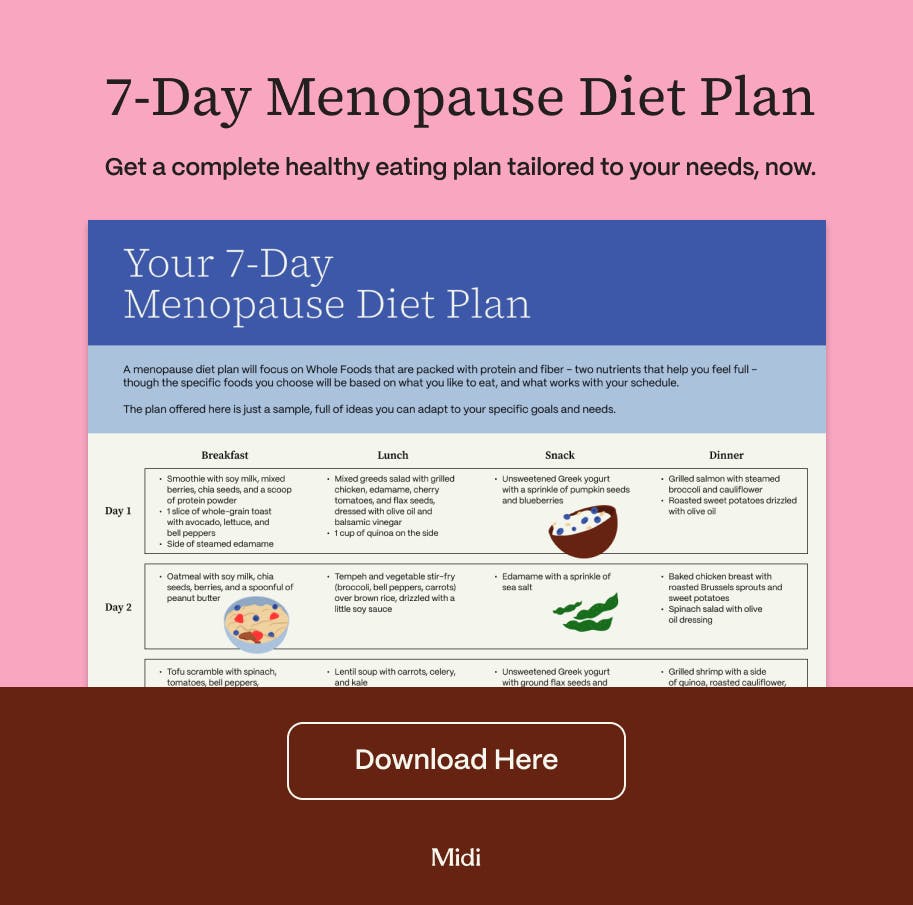If you’re taking a weight loss medication and constantly wondering what to eat on Ozempic, or another GLP-1 receptor agonist, you’ve come to the right place. The quickest route to reach your health goal is to pair the medication with a healthy diet (and exercise). But that can come with challenges as GLP-1s can impact your appetite and cause gastrointestinal side effects that may tank your desire for food. While curbing appetite is one of the intended outcomes, you don’t want to miss out on vital nutrients your body needs. Here’s what you need to know to maximize your diet while on Ozempic to meet your nutritional needs, decrease side effects, and feel great.
Stumped on what to eat while taking Ozempic? You’re hardly alone. With all the fanfare surrounding medications like Ozempic—especially on their ability to make you less hungry all the time—it can be tricky to know what to eat. Let’s face it, a “healthy diet” can mean a lot of different things and doesn’t provide much guidance, especially if you struggle to eat in a balanced way.
The good news: These meds are on your side. Due to how they work, GLP-1s can help you change your eating habits to choose more nutritious foods that promote weight loss. (That’s a win-win.)
If you’re taking Ozempic or another GLP-1 receptor agonist for diabetes management or weight loss, here’s what to eat on Ozempic and how to choose foods that meet your nutritional needs, while helping you avoid unwanted side effects of the medications.
And because your nutritional needs may shift with age, especially as you go through perimenopause and menopause, we’ve also included tailored advice for your 30s, 40s, 50s, and 60s. Keep reading to learn more.
GLP-1 Medications: Know Your Options
While many people use “Ozempic” as a catchall for many different GLP-1 medications that help with weight loss and blood sugar control, there are so many options and it can be hard to keep the names straight. While your healthcare provider will go over the options best suited for you, here’s how they break down:
GLP-1 Receptor Agonist Drugs
- Semaglutide: Ozempic, Wegovy, Rybelsus
- Liraglutide: Victoza, Saxenda
- Dulaglutide: Trulicity
Dual GIP/GLP-1 Receptor Agonists
- Tirzepatide: Mounjaro and Zepbound
Ozempic and similar medications work on multiple fronts to help control blood sugar and produce weight loss. Specifically, Ozempic helps:
- Your pancreas produce more insulin, a hormone that helps “push” blood sugar into cells for energy.
- Control the liver’s production of blood sugar.
- Helps slow digestion, helping you feel fuller longer.
The result? The medication assists in better blood sugar control and can help keep you fuller longer, thus reducing your appetite. In addition, medications like semaglutide may work on the appetite centers in the brain to reduce “food noise,” or pesky—and intrusive—thoughts about food. Research shows that taking a GLP-1 or GIP/GLP-1 may reduce calorie intake by 16 to 39%, leading to weight loss.
Despite these welcome changes to blood sugar regulation and appetite, you may need to adjust your diet to ensure you’re meeting your nutrient needs. There is no one-size-fits-all Ozempic diet plan. A personalized approach, which considers your unique needs, preferences, and side effects from the medications, will help you successfully move toward your health goals.
Working with a healthcare professional, like a Midi clinician, can help you get closer to your weight and overall health goals. At Midi, we prescribe personalized GLP-1 prescriptions for weight loss.
General Guidelines for Eating on Ozempic
An Ozempic diet plan can accommodate different diets (like plant-based, vegetarian, or vegan), as well as your own food and cultural preferences. In other words: Ditch any stringent rules you’ve heard about eating on Ozempic. Instead, here are the basic tenets of a healthy, nutritious eating plan on a GLP-1:
- Prioritize protein: Protein helps maintain muscle mass, which is especially important when you’re losing weight. It also helps you feel fuller longer, which, in turn, can naturally reduce the number of calories you consume in a day. This will be key if you’re reducing your calorie intake. Focus on poultry, fish, lean cuts of pork and beef, and plant sources like tofu, tempeh, beans, and lentils.
- Fill up on fiber: Fiber is a nutrient that is filling, slows digestion to support blood sugar regulation, promotes gut health, and encourages healthy stools. Constipation is common on these medications, so foods high in fiber (think leafy greens, whole wheat and nuts and legumes) can help keep things moving.
- Add in healthy fats: Eating healthy fats like olive oil, avocado, fatty fish like salmon and sardines, as well as nuts and seeds, can help balance blood sugar and keep your heart in shape.
- Stay hydrated: Drinking enough fluids—especially water—can prevent dehydration and decreases the risk of constipation. Aside from plain water, you can stay hydrated by drinking coconut water, herbal teas, and infused water, and even by eating water-rich foods like watermelon, oranges, strawberries, cucumbers, and lettuce.
- Consume smaller meals more frequently: Gastrointestinal side effects are the most common when taking a GLP-1, with some nausea and even occasional vomiting. So, what can you eat on Ozempic to avoid nausea? Go for smaller meals, as having too much food “sitting in your stomach” can make you queasy and bloated.
Foods for a Healthy Diet
Among all of the diets out there, one stands out as a gold-standard for health and weight loss: The Mediterranean Diet. This eating plan is primarily plant-based, with some lean protein and dairy in moderation. Here’s what to focus on:
- Protein: Eggs, chicken, turkey, lean and fatty fish, tofu, tempeh, edamame, lentils, beans, and some dairy like yogurt or kefir.
- Whole grains: Brown rice, quinoa, whole-grain bread and pasta, farro, bulgur, oats, amaranth, and more.
- Vegetables: Whatever veggies you like, load ‘em on your plate. Broccoli, cauliflower, green beans, cucumbers, bell peppers, eggplant, carrots (and many more!) are all fair game and should be consumed in abundance.
- Fruits: Ignore the “but it has sugar!” argument—fruits have natural sugars encased in a package of vitamins, minerals, fiber, and disease-protecting antioxidants. Berries, citrus, apples, melon, peaches and plums, and more are all good choices.
- Nuts and seeds: Almonds, walnuts, pistachios, cashews, chia, flax, and hemp provide a trifecta of protein, fiber, and healthy fats for blood sugar regulation and overall health.
Foods to Limit or Avoid
GLP-1s, like Ozempic, are designed to be paired with a healthy, balanced diet, so you should generally limit foods that are high in calories and low in nutrition. Plus, making sure the foods you eat are high in nutrients will give you the most sustained energy and help you feel your best. Here are the foods to limit or avoid while taking Ozempic:
- High-fat foods: Fried foods, fast food, and greasy food can take a long time to digest (and sit like a rock in your stomach). They also tend to be high in calories and low in good-for-you nutrients, so they may stall weight loss, cause GI upset, and mess with blood sugar regulation.
- Refined carbohydrates and sugary foods: Refined carbohydrates include foods like white bread, French fries, donuts, cakes, and other high-sugar foods. Additionally, things like soda, fruit juice, and sweet tea are high in sugar, which can lead to an imbalance in blood sugar.
- Ultra-processed foods: Ultra-processed foods undergo a lot of changes, and are often higher in calories, added sugars, sodium, and unhealthy fats. Examples include fast foods, frozen foods like pizza and ready meals, condiments like ketchup and BBQ sauce, chips, pretzels, and candy.
- Alcohol: Alcohol doesn’t offer much nutritional value but can easily add extra calories to your diet. Even a small amount may increase the risk of certain cancers, like breast cancer. Interestingly, there’s research in JAMA Psychiatry to suggest that taking semaglutide (the medication in Ozempic and Wegovy) is associated with less drinking and craving for alcohol—so reducing your intake may be easier when you’re on a GLP-1.
Managing Blood Sugar
Ozempic will help reduce your blood sugar, but it’s still important to establish healthy habits that support a balanced diet, including:
- Exercising, especially after meals. Physical activity improves insulin sensitivity and helps your muscles make use of the glucose from food. Research shows that walking after a meal leads to lower blood sugar levels after eating.
- Eating regular meals. Skipping meals can send your blood sugar on a rollercoaster, while regularly eating can help keep your levels more even.
What to Eat on Ozempic in Your 30s
If you’re in your 30s, embrace this time to set up healthy habits that you can follow for the long haul (yep, for the rest of your life). One of the biggest things you can do right now is ensure you’re eating enough protein and fiber. A main concern when taking a GLP-1, such as Ozempic, is that it may decrease your appetite to the point where you aren’t eating enough food in general, which can lead to problems like inadequate protein and fiber intake.
When you lose weight, some of that comes from water, fat, and muscle. For long-term weight loss, the key is to lose weight from fat while minimizing weight loss from muscle. (Losing a lot of muscle during weight loss sets you up for weight regain—and ending up with a greater proportion of body fat.)
Compounding the problem? Aging also plays a role in muscle loss—and it starts earlier than you may think. . In your 30s, you begin to lose about 3 to 5% of your muscle mass per decade. Focusing on protein intake and regularly exercising will help you maintain muscle mass.
Additionally, many diets lack important nutrients like fiber, vitamin D, iron, calcium, and potassium. This can be a challenge if you’re on a GLP-1, like Ozempic, due to a reduced appetite. This is a great time to check in with a healthcare professional, like a Midi clinician, to monitor any nutrient deficiencies, and, if necessary, adjust your diet and add supplements.
When putting together your diet, get the nutrients you need by filling up on the following foods:
- Lean proteins, including chicken, fish, and tofu.
- Whole grains like oats, farro, brown rice, and whole-wheat breads and pastas
- Legumes like beans and lentils
- Vegetables and fruits (take your pick!)
- Dairy and plant-based alternatives like yogurt, kefir, and cheese
What to Eat on Ozempic in Your 40s
For most women, perimenopause begins in their mid-40s. (Though it can be as early as your 30s or as late as your 50s.) And it couldn’t happen at a more inconvenient time. Hormones begin to fluctuate when life may be at its busiest. As a result, you may have less time to exercise, more stress, and a metabolism that’s no longer working in your favor—all things that can make perimenopause weight gain more common.
During these years, some women add a GLP-1, like Ozempic, to a healthy diet and lifestyle for weight management or as a treatment for diabetes. If you’re taking one of these medications, here’s what to focus on:
- A protein-rich diet to counteract muscle loss that occurs due to weight loss.
- Anti-inflammatory foods like colorful fruits and vegetables, garlic, fatty fish, olive oil, nuts, and seeds to support joint and heart health (which also get negatively impacted by the hormonal effects of perimenopause).
- Limiting refined carbohydrates and foods high in added sugars, which tend to provide excess calories without offering much nutrition. A diet rich in refined carbohydrates and added sugars is associated with an increased risk of chronic disease, per research in Clinical Nutrition. Since the menopausal transition is associated with health problems like heart disease, it’s important to take advantage of the appetite changes that may occur with a GLP-1 to decrease your intake of foods in this category.
What to Eat on Ozempic in Your 50s
Now is the time to really focus on your bone health. Declining estrogen levels with menopause speed up bone loss, according to the American Academy of Orthopaedic Surgeons. If you’re on a GLP-1, there’s some data that shows that taking one of these medications (liraglutide) alone leads to weight and fat loss as well as decrease in spine and hip bone mineral density compared to placebo. That research, published in JAMA Network Open, found that GLP-1 treatment plus exercise was the most effective strategy for weight loss and maintaining bone health.
When it comes to diet, here’s what to eat:
- Foods that are rich in calcium and vitamin D to help prevent osteoporosis, such as fortified dairy and plant-based alternatives, as well as fatty fish like salmon and sardines.
- Anti-inflammatory foods to help reduce the risk of chronic disease like colorful fruits and vegetables and omega 3-rich foods like fatty fish, hemp, and chia seeds.
- Sources of protein, as protein is also involved in maintaining muscle mass, bone metabolism, and a lower risk of fracture. Animal-based protein sources include beef, chicken, turkey, pork, fish, eggs. Plant-based sources include legumes like lentils and chickpeas, soy products like soy milk, tofu and tempeh, nuts and seeds, and whole grains like quinoa.
What to Eat on Ozempic in Your 60s and Beyond
In your 60s and beyond, there are a few key considerations. As you age, you’re more at risk for nutritional deficiencies due to shifts in appetite (with or without GLP-1s), changes in daily activity, hormonal changes, and more. This may increase your risk for muscle loss and conditions like osteoporosis and sarcopenia. Plus, your sense of thirst can decrease, so you may find it harder to hydrate properly.
Naturally, these are all things you want to avoid, but when you add a GLP-1 in the mix, you may have additional challenges with your appetite and food intake. Your body may require fewer calories, but it still needs enough nutrients to truly thrive—so you want to make the food you eat work for you.
Here’s what you can do:
- Prioritize fiber and fluid. Drinking enough liquids will also help to prevent dehydration.
- Consume protein-rich foods for muscle health and function, and bone density.
- Eat a heart-healthy diet that’s low in saturated fat. One study in Nature Medicine found that older adults who ate a healthy, plant-based diet featuring a greater intake of fruits, vegetables, whole grains, unsaturated fats, nuts, legumes, and low-fat dairy had 86% higher odds of healthy aging compared to those who ate less healthy diets (with foods high in trans fats, sodium, sugary drinks, and red/processed meats.)
True Stories Of Transformation
Tips for a Successful Ozempic Diet
If you’re on a GLP-1 medication like Ozempic, you’ll probably notice changes to how fast you become full after eating, your appetite, and even the types of foods you crave. Although these medications are effective for managing blood sugar and/or causing weight loss, they are not all you need, as they’re intended to be used alongside a healthy diet and exercise plan. Plus, they can cause GI side effects that make it challenging to eat enough and eat well. Here’s how to make it work for you:
- Work closely with a prescribing healthcare professional, like a Midi clinician.
- Consult a registered dietitian, particularly one who specializes in working with women on GLP-1s, to help create a personalized diet that meets your nutrient needs based on your health, age, and stage of life.
- Keep a food diary to track your food intake. This can help you identify areas where you may be lacking certain macronutrients, vitamins, or minerals.
- Eat smaller, more frequent meals, which can help reduce nausea and vomiting. Instead of 2-3 larger meals, aim for 3-5 smaller meals.
- Eat slow. These meds slow digestion, so eating too fast can lead to nausea or discomfort. Chew thoroughly and give your body time to feel full.
- Eat fiber-rich foods throughout the day. Fiber is good for your heart health, gut microbiome, and can help relieve common Ozempic side effects like constipation or diarrhea.
- Stay hydrated by drinking plenty of water, herbal teas, and electrolyte-rich drinks.
- Consider a supplement or two. If your food intake drops, you may not meet your vitamin and mineral needs. Consider a high-quality multivitamin or other supplements like vitamin B12 and iron. A Midi clinician can help recommend supplements to meet your needs.
Common Mistakes to Avoid
First of all, no one has the perfect diet—whether they’re on a GLP-1 or not. So make sure you’re approaching your food choices with compassion, especially if you’re trying to make significant shifts in your eating habits. With that in mind, here are some common mistakes that can get in the way of your success:
- Skipping meals, which can increase your risk of low blood sugar. .
- Eating large meals, which may contribute to GI side effects like nausea and bloating.
- Getting dehydrated or not eating enough fiber, which can cause constipation, a common side effect of Ozempic.
- Skimping on protein, which can sabotage your efforts to preserve muscle mass as you lose weight.
- Relying too much on ultra-processed foods like fast food, frozen meals, chips, cookies, and cakes.
- Not working with a healthcare provider to monitor your diet and any nutrient deficiencies.
Key Takeaways
- Ozempic (semaglutide) is a GLP-1 receptor agonist medication that treats type 2 diabetes by delaying stomach emptying, increasing insulin production, and reducing appetite.
- Some people also find they lose weight on Ozempic, but there are other GLP-1 and GLP-1/GIP medications indicated for weight loss and obesity like Wegovy (semaglutide) and Zepbound (tirzepatide).
- When it comes to your diet, following a balanced, healthy eating pattern will provide your body with the nutrients it needs to thrive, manage blood sugar, and support weight loss when you’re on a GLP-1.
- The most common side effects from GLP-1s are gastrointestinal problems like constipation, diarrhea, nausea, vomiting, and bloating. Consuming smaller meals and getting enough fiber and fluid can help decrease the risk of some of these issues.
- Eat ample protein from lean sources like eggs, poultry, fish, soy, and dairy to help stabilize blood sugar and maintain muscle mass while you lose weight. This is important for helping you maintain that loss long-term.
- Work closely with your healthcare professional to report progress and any side effects. Consider connecting with a dietitian, especially if you’re finding it difficult to eat enough or are worried about nutrient deficiencies.
Frequently Asked Questions (FAQs)
What are the best foods to eat while on Ozempic?
When you’re taking a GLP-1 receptor agonist like Ozempic, focus on foods that are rich in lean protein and fiber. Sources of lean protein include eggs, chicken and turkey, fish, tofu, and lean cuts of pork and beef. Fiber-packed foods are those like vegetables, fruits, legumes, nuts and seeds, and whole grains. Both protein and fiber are important for satiety, but protein also helps you maintain muscle mass during weight loss, and fiber keeps you regular, decreasing the risk of some of the GI side effects that occur on Ozempic.
How to speed up weight loss on Ozempic?
Ozempic, and other GLP-1s, are intended to be used alongside a healthy, balanced, calorie-restricted diet and regular exercise routine. Making these lifestyle changes can help speed up weight loss.
What not to eat or drink while on Ozempic?
Ozempic slows stomach emptying. That has the benefit of keeping you full, but it can also mean that certain meals feel heavy in your stomach. For that reason, when it comes to Ozempic foods to avoid, limit your intake of large, fatty, fried, or greasy meals, which can contribute to GI side effects like nausea on Ozempic. Also, avoid meals that are high in refined carbohydrates (or generally unbalanced), as these can cause a rapid spike in blood glucose, and work against efforts to manage your blood sugar.
What is the meal plan for Ozempic?
There isn’t one set meal plan for Ozempic, as everyone has different dietary needs, food preferences, and goals. What is clear is that following a balanced diet, such as a Mediterranean diet, will provide your body with nutrients you need to feel your best, help you manage your blood sugar, and support weight loss.
If you’re in perimenopause or menopause and want guidance from clinicians who specialize in women’s midlife health, book a virtual visit with Midi today.
Hormonal change is at the root of dozens of symptoms women experience in the years before and after their period stops.
Our trained menopause specialists can help you connect the dots to guide you towards safe, effective solutions.
Whether you need personalized guidance or a prescription routine to tackle symptoms—including vaginal dryness and irritation, brain fog, hot flashes, sleep trouble, mood swings, and weight gain—we’ve got you covered.
Midi’s mission is to revolutionize healthcare for women at midlife, wherever they live and whatever their health story. We believe that starts with education, to help all of us understand our always-changing bodies and health needs. Our core values guide everything we do, including standards that ensure the quality and trustworthiness of our content and editorial processes. We’re committed to providing information that is up-to-date, accurate, and relies on evidence-based research and peer-reviewed journals. For more details on our editorial process, see here.


 Victoria Eaton, RDN, LDN, IFNCP
Victoria Eaton, RDN, LDN, IFNCP




